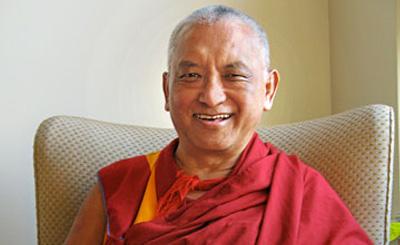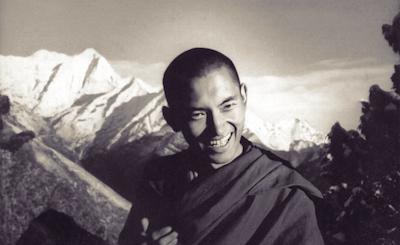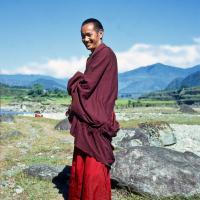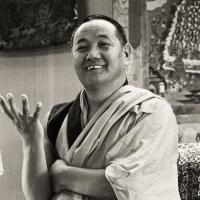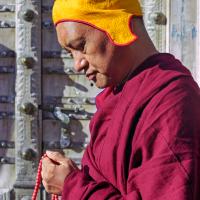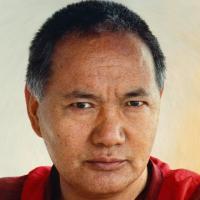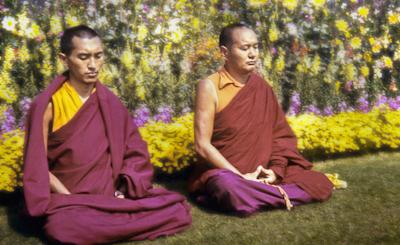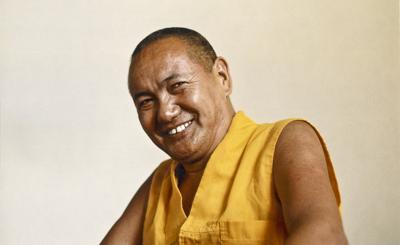MEDITATION ON THE AWARENESS OF THE REAL I
[Rinpoche starts talking while standing in front of the throne]
Before we sit down, what do you think? Is the weather good or bad? It depends on how you think. It can be good. Everything is good for people who think good; everything is bad for people who think bad. It depends on what you think. The weather being good or bad depends on how you label it.
So, we can do the walking meditation on emptiness. Use the simple, clear example of the I, what I introduced about the I, about the I that exists and the I that does not exist. That is the reality. I, action, object, hell and enlightenment, samsara and nirvana, happiness and problems, all the other things exist in mere name, merely labeled by the mind. Being merely labeled means things do not exist from their own side; it cuts off existing from there. That’s the reality.
Maybe I’ll sit down a little bit, OK. [A low throne is brought for Rinpoche and he sits down]
Recently, when I was in Washington where we have a retreat place, I was supposed to go for a walk every day for health, because I have diabetes. I don’t have high blood pressure but it needs to go down for the diabetes, but I didn’t get it done. One day I went for a walk from the retreat place to get down to the main road. Down there are two monks who take care of the retreat place, setting up all the offerings, in the upstairs three large rooms and downstairs, all the huge water offerings, all the many light offerings. I think there are three or four rooms. Every morning they spend two or three hours cleaning and making offerings. Besides these two other monks, there are also Sherab and Roger.
Going down, I was explaining the way to do the walking meditation related to impermanence. I explained it on the basis of the eight freedoms and ten richnesses that we have received, the usefulness and how difficult it is to find again. Then, not only is death definite, but the time of death is indefinite; it can happen at any time. So, going down the road, however many seconds it takes, you have from now on up to the death. As you are going down, you practice the awareness of how with each second, that is one second closer to death. As you walk, so many seconds are finishing and life is becoming shorter and shorter; you are rushing closer and closer to death, and especially to the lower realms if you have not practiced the Dharma and purified your negative karma. You are getting so close to the lower realms, to the hells. You practice that awareness when you are going down.
Then going up, I introduced the two monks to mainly focus on the object to be refuted, the false I. Going up, I introduced them to that, looking at that which is a hallucination as a hallucination. That was the meditation.
Then, after explaining these two meditations, I explained what was totally understood, how [we think] this real Amitabha Buddha Pure Land retreat house—that is the name of the retreat house—is something concrete, something real, existing from there. Living in that house, I saw that it was not there. It was not there. That which I believed to be truly existent, that real Washington retreat house, Amitabha Buddha Pure Land, which seemed so real, with that meditation I could see it was not there.
Of course, because my mind has been habituated with ignorance from beginningless time, not only from this morning or from birth, because it is habituated with that belief in true existence so strongly, I could not stay in that awareness. Yes, that is the reality, and the mind is supposed to stay in that state, but the problem was I could not stay like that, because of my habituation. My mind was supposed to stay in that state of awareness but very quickly everything went back to seeming real. I’m just telling the story.
First, remember how we created the I, with the aggregates as the base to be labeled “I.” The I is what is labeled and then the base to be labeled “I” is the aggregates. The mind, focusing on the aggregates, makes up the label “I,” merely imputing it. That merely means there is totally nothing from there that is true; it is just a label. Meditate on the reality.
We will meditate a little. Then after that, meditate on the body and mind—the aggregates—and then form, sound, smell, taste, and all the rest of the phenomena, how they are all like that, merely labeled by the mind. Things do not exist from their own side. There is nothing real. There is no real I, and the same with the rest. There is nothing real. It appears to ignorance as real, but in reality there is nothing. So, we will start with the I.
[Long pause for meditation]
While the I is mere name, merely labeled by the mind, what the I is, is extremely subtle. It comes down to the same point, that the I is not existing from its own side, it’s totally empty from its own side, and at the same time think that it exists in mere name, by thinking of the subtle dependent arising. There is no I from there. If you see that the I is empty of existing from its own side, the real I, then that causes you to realize that the I exists in mere name.
As I said before, meditate on how everything—the body and mind, the aggregates, and then gradually everything else—exists in mere name. This allows you to see it is empty from its own side.
[Long pause for meditation]
Practice that awareness. The conclusion is that all phenomena exist in mere name. That means that nothing exists from there; everything is totally empty from there.
[Long pause for meditation]
You need to meditate much longer, but anyway, next, you see that the I has to appear back that way. What is merely labeled by the mind in the first moment has to appear back to you like that. It should appear back to you merely labeled by the mind as it happened a moment before, but for us sentient beings it appears back as truly existent, existing from its own side, existing by nature, a real I. The I is merely labeled but when it appears back, negative imprints collected from beginningless rebirths due to ignorance holding the I as truly existent—that particular ignorance, not just any ignorance, but your own root of samsara—those negative imprints decorate true existence onto that merely labeled I, making it seem that it exists from its own side, existing by nature. The real I, the false I is projected, decorated onto that merely labeled I.
Practice the awareness of this false I. Our mind has been habituated from beginningless rebirths to this real I, thinking this is true and believing it as true, from beginningless rebirths. The habituated is false but we believe it is true, having been habituated from beginningless rebirths. We now have to look at it as false for a while. Be mindfulness of that, looking at it as false, as the object to be refuted.
[Long pause for meditation]
Our mind has to now become habituated in a positive way, habituated to looking at it as false. We have been suffering in the six realms of samsara, one after the other, numberless times from beginningless rebirths, experiencing the most unimaginable suffering, such as the suffering the hell realm numberless times because of believing that the I that appears real is true. That is where all the delusions have come from, all the karma, all the three types of suffering; the suffering of pain, the suffering of change and pervasive compounded suffering. So, now we have to habituate ourselves in a positive way, thinking this is false. This is the mindfulness practice we must do in our everyday life.
We need to live our life in meditation on the three principal aspects of the path to enlightenment: renunciation, bodhicitta and right view. This is right view. We have to put all our effort, our whole life, day and night, into this, by looking at what appears as real from there, looking at it all as false, including the I.
In this way, even if we have a real relationship with our husband or wife, with our children, parents, friends and enemies, even when birth and death happen for us or our family, we will see that there is no real death, there is no real birth, there is no real old age and sickness. There is only a merely labeled one. There is nothing else there, no real death or real birth, nothing, including ourselves, our family or our loved ones.
We need to get habituated. The main practice of emptiness in daily life is to get habituated in a positive way, seeing that all the real things appearing from there are all false, like the I, like hell and enlightenment, like samsara and nirvana, like happiness and problems, everything that appears from there. From our side, we need to look at all this as false instead of real. Instead of trusting it is true, we need to see the false as it is, as false. That is what we need to train the mind in. It is one of the most important meditations in life. We need to do that to free ourselves from the oceans of the most unimaginable suffering of samsara, to free ourselves forever. Then, we can help all sentient beings to be free from oceans of suffering of samsara forever!
Meditating on emptiness has these benefits even without talking about enlightenment. It’s the answer for all the problems we dislike; it’s the answer for what we should do. It’s the ultimate answer, the best psychology.
Just like being aware of the real I, when we are walking we should be aware of the real action of walking, the real object of the road, the real sky, the real earth, the real trees, everything. We should practice the awareness of looking at everything as a hallucination, looking at that which is a hallucination as a hallucination. The practice of awareness is complete in that. In reality, [what we assume to be real] is not there. Even if we have some problems, such as relationship problems or problems in the family, when we think in that way, that it is just merely labeled, what happens is, when we see it as merely labeled by the mind, that there is no real thing, it brings incredible peace in our mind even right now. It no longer drives us crazy. It brings us great peace. With the help of bodhicitta, it leads to liberation and enlightenment.
We’ll continue walking with this awareness. Don’t talk. If you end up talking, it distracts you. This is important, so just meditate, just practice this awareness.
I mean, maybe you are going shopping in Kathmandu or whatever, or on pilgrimage or sightseeing. You can do the same thing on your way back from Kathmandu. When you go out, you can meditate on subtle dependent arising, how everything exists in mere name; you can practice that awareness. And when you come back, you can do that, or do it with bodhicitta, or you can just meditate on emptiness as I have explained, in the three ways: looking at that which is a hallucination as a hallucination, looking at everything as merely labeled, how this I is merely a labeled I, this walking is merely labeled walking, this road is a merely labeled road, paying for shopping is merely labeled paying money, and a merely labeled shopkeeper, and merely labeled things. You can do it like that. Or you can look at everything as empty. So, you can practice awareness in those three ways.
OK. So, we’ll go down. Maybe we’ll go around Geshe Lama Konchog’s stupa five or six times, then come back. Then we’ll start all over again. OK.
[Rinpoche seems as if he is about to start teaching again]
I think maybe not; I won’t talk to you at the moment. It’s too much but there is an incredible prayer for going around the stupa.
[Rinpoche leads a walking meditation outside around the stupas]







